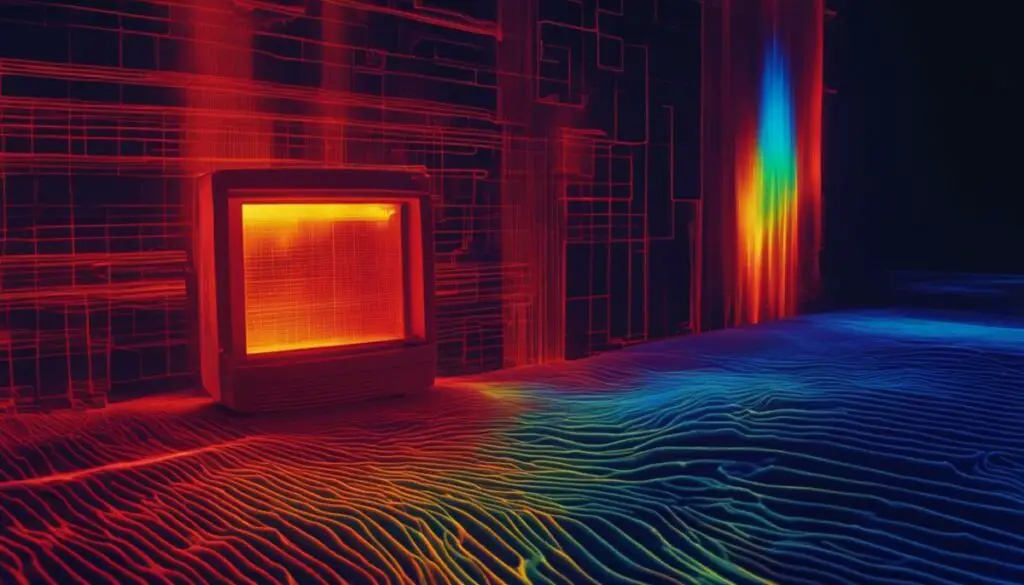Last Updated on 4 months by Francis
Welcome to our article on infrared waves. In this section, we will explore whether infrared waves are electromagnetic or mechanical in nature and their position within the electromagnetic spectrum. Understanding these concepts is crucial for appreciating the applications and properties of infrared waves in various fields.
Before we delve into the topic, let’s clarify some key terms. Infrared waves are a type of electromagnetic radiation, much like light waves. However, they are not mechanical waves like sound waves. Instead, they are part of the broader spectrum of electromagnetic waves that includes radio waves, microwaves, visible light, and more.
Contents
Key Takeaways:
- Infrared waves belong to the electromagnetic spectrum, not the category of mechanical waves.
- Infrared waves are a form of electromagnetic radiation, similar to light waves.
- Understanding the distinction between electromagnetic and mechanical waves is essential in comprehending the behavior and applications of infrared waves.
Understanding Electromagnetic Waves

Electromagnetic waves are a fundamental aspect of the electromagnetic spectrum. They encompass a vast range of wavelengths and frequencies, with each type of wave possessing unique characteristics and properties. One prominent member of the electromagnetic wave family is infrared waves, which fall within the lower end of the spectrum.
At their core, electromagnetic waves consist of oscillating electric and magnetic fields, propagating through space in a wave-like manner. What sets these waves apart from mechanical waves, like sound waves, is their ability to traverse through a vacuum at the universally constant speed of light. This remarkable attribute empowers electromagnetic waves to travel vast distances, enabling us to observe celestial objects and communicate over long distances.
The electromagnetic spectrum encompasses a wide range of wavelengths and frequencies, from radio waves with the longest wavelengths to gamma rays with the shortest. Each type of wave is classified based on its distinctive position in the spectrum. Infrared waves, occupying a position between microwaves and the visible light range, are utilized in various practical applications due to their unique properties.
To better understand the electromagnetic spectrum, it is crucial to comprehend the role of wavelength and frequency. Wavelength refers to the spatial distance between successive wave crests, while frequency indicates the number of wave cycles occurring per second. These characteristics determine the position of electromagnetic waves within the spectrum and influence their behavior and interactions with matter.
The Electromagnetic Spectrum
Here is a simplified overview of the electromagnetic spectrum, highlighting the key regions and their corresponding wave types:
| Region | Wave Type | Properties | Applications |
|---|---|---|---|
| Radio Waves | Longest wavelengths | Used in broadcasting and telecommunications | Radio communication, broadcasting |
| Microwaves | Shorter wavelengths than radio waves | Heating food, radar technology | Microwave ovens, radar systems |
| Infrared Waves | Next to the visible light range, longer wavelengths | Heat radiation, remote sensing | Thermal imaging, night vision |
| Visible Light | Comprised of various colors (wavelengths) | Enables human vision | Optics, photography, illumination |
| Ultraviolet (UV) Radiation | Shorter wavelengths than visible light | Causes sunburn, germicidal properties | Skin treatment, sterilization |
| X-rays | Short wavelengths, high energy | Penetrating properties | Medical imaging, airport security |
| Gamma Rays | Shortest wavelengths, highest energy | Nuclear and particle interactions | Radiation therapy, nuclear research |
“Electromagnetic waves are the backbone of modern communication systems, enabling us to transmit information across vast distances and see beyond the limits of our natural vision.”
The Nature of Infrared Waves

Infrared waves, also known as infrared radiation, occupy a unique position within the electromagnetic spectrum. With wavelengths longer than visible light but shorter than microwaves, they play a crucial role in various scientific and technological applications.
One defining characteristic of infrared waves is their association with heat radiation. These waves are emitted by objects with temperatures above absolute zero. In fact, the term “infrared” itself translates to “below red,” referencing their longer wavelength compared to red light in the visible spectrum.
Infrared technology harnesses the unique properties of these waves for a wide range of applications. One notable use is in infrared detectors, which are instrumental in thermal imaging and sensing heat signatures. These detectors can measure and convert infrared radiation into useful data, enabling advancements in fields such as firefighting, security, and industrial inspections.
Another significant application of infrared technology is thermal imaging cameras. By detecting and converting infrared radiation into visible images, these cameras enable the visualization of temperature variations in objects and environments. This capability has widespread uses in areas including building diagnostics, medical imaging, and search-and-rescue operations.
In summary, infrared waves, with their distinct position in the electromagnetic spectrum, offer valuable insights and practical applications. Whether it’s detecting heat signatures with infrared detectors or visualizing temperature variations with thermal imaging cameras, the unique nature of infrared waves continues to unlock new possibilities in various fields.
The Difference Between Mechanical and Electromagnetic Waves

When it comes to waves, there are two main categories: mechanical waves and electromagnetic waves. Understanding the difference between these two types of waves is crucial in grasping the fundamental principles of wave behavior and energy transfer.
Mechanical Waves
Mechanical waves require a medium to propagate. They involve the physical motion of matter, such as particles in a solid, liquid, or gas, and transfer energy through mechanical vibrations. These waves can be seen in everyday phenomena, such as water waves at the beach or the sound waves that allow us to hear music and conversation.
One example of a mechanical wave is a water wave. As a disturbance, such as a pebble dropping into a pond, moves through the water, it causes the particles in the water to oscillate in a wave-like pattern. This motion then transfers the energy of the disturbance from one point to another.
Electromagnetic Waves
On the other hand, electromagnetic waves, including infrared waves, do not require a medium to propagate. They can travel through empty space, which sets them apart from mechanical waves. Electromagnetic waves are composed of oscillating electric and magnetic fields and transfer energy through the interaction of these fields.
The motion of charged particles, such as electrons, creates electromagnetic waves. When an electric field accelerates these charged particles, it generates a changing magnetic field. Similarly, a changing magnetic field can produce an electric field. These oscillating fields create a self-sustaining cycle, resulting in the propagation of electromagnetic waves.
An important example of an electromagnetic wave is infrared radiation. Infrared waves are a form of electromagnetic radiation with wavelengths longer than those of visible light. They are commonly associated with heat and are emitted by objects above absolute zero temperature. Infrared technology, such as thermal imaging cameras, utilizes these waves to detect and analyze heat signatures in various applications.
Here is a brief comparison of mechanical waves and electromagnetic waves:
| Mechanical Waves | Electromagnetic Waves |
|---|---|
| Require a medium to propagate | Do not require a medium; can travel through empty space |
| Involve the motion of matter | Involve oscillating electric and magnetic fields |
| Transfer energy through mechanical vibrations | Transfer energy through the interaction of electric and magnetic fields |
By understanding the distinction between mechanical waves and electromagnetic waves, we gain insights into how energy is transmitted and the unique characteristics of different types of waves. This knowledge is essential in various scientific, technological, and everyday applications.
In the next section, we will delve deeper into the role of infrared waves in the electromagnetic spectrum and explore their applications in different fields.
Infrared Waves in the Electromagnetic Spectrum
Infrared waves are an integral part of the electromagnetic spectrum, a vast range of electromagnetic energy that includes radio waves, microwaves, visible light, ultraviolet radiation, X-rays, and gamma rays. Within this spectrum, infrared radiation occupies a unique position, characterized by its longer wavelength and lower energy compared to visible light, while carrying higher energy than microwaves.
Infrared waves play a crucial role in various scientific, technological, and everyday applications. They are utilized in fields such as communication, remote sensing, data transmission, and even medical diagnostics. Understanding the position of infrared waves within the electromagnetic spectrum is essential for comprehending their behavior and harnessing their potential.
To illustrate the electromagnetic spectrum and the placement of infrared waves, we can refer to the following table:
| Electromagnetic Wave | Wavelength Range | Energy Range |
|———————-|—————–|——————————–|
| Radio Waves | >1 mm | Low |
| Microwaves | 1 mm – 1 m | Moderate |
|
Infrared Waves
|
750 nm – 1000 μm
|
Intermediate
|
| Visible Light | 390 – 750 nm | Low to Intermediate |
| Ultraviolet | 10 – 390 nm | High |
| X-rays | 0.01 – 10 nm | Very High |
| Gamma Rays |
This table clearly depicts the electromagnetic spectrum, showcasing the various types of waves, their respective wavelength ranges, and energy levels. Within this range, infrared waves exhibit properties that make them suitable for diverse applications, from thermal imaging to utilization in infrared technology.
Infrared Waves: Energy and Wavelength
As mentioned earlier, infrared waves have a longer wavelength compared to visible light. Their wavelengths typically range from around 750 nanometers (nm) to 1000 micrometers (μm). This longer wavelength corresponds to lower energy levels in the electromagnetic spectrum.
Despite having lower energy than visible light, infrared waves have higher energy than microwaves. This unique energy range allows infrared radiation to interact with different materials and substances in various ways. For example, the interaction of infrared waves with certain molecules can result in absorption, transmission, or reflection, leading to applications in fields such as spectroscopy, remote sensing, and thermal imaging.
Furthermore, the energy and wavelength characteristics of infrared waves determine their differential behavior when compared to other waves in the electromagnetic spectrum. Understanding these properties is crucial for effectively utilizing infrared radiation in scientific research, industrial applications, and everyday technology.
The Properties of Infrared Waves

Infrared waves share several properties with other electromagnetic waves, including reflection, refraction, interference, and diffraction. These properties allow for the manipulation and control of infrared waves, making them invaluable in various scientific and technological applications.
Reflection occurs when infrared waves bounce off a surface, changing direction but maintaining their frequency and wavelength. This property is exploited in applications such as optical mirrors and thermal radiation reflectors.
Refraction is the bending of infrared waves as they pass through different mediums, caused by a change in their speed. This phenomenon is utilized in devices like lenses and prisms, enabling the focusing and redirection of infrared radiation.
Interference occurs when two or more infrared waves overlap, either constructively or destructively. Constructive interference results in reinforcement, while destructive interference leads to cancellation. This property is employed in various technologies, such as infrared spectroscopy and interferometry.
Diffraction refers to the bending and spreading of infrared waves as they encounter obstacles or openings that are comparable in size to their wavelength. This property is utilized in diffraction gratings, allowing for the separation of different wavelengths within the infrared spectrum.
Infrared waves exhibit similar properties to other electromagnetic waves, including reflection, refraction, interference, and diffraction, which enable their manipulation and control for scientific and technological applications.
These properties of infrared waves make them invaluable in various fields. For example, in spectroscopy, the interaction of infrared waves with matter provides valuable insights into the composition and structure of substances. Infrared cameras and sensors use these properties to detect thermal radiation and capture images in the dark or through certain materials. Additionally, the properties of infrared waves are utilized in remote controls, heating systems, and communication technologies.
In summary, the properties of reflection, refraction, interference, and diffraction make infrared waves versatile and useful in a wide range of scientific, technological, and everyday applications.
Applications of Infrared Waves

Infrared waves have a wide range of practical applications in various fields. The advanced technology driven by infrared waves has revolutionized multiple industries, enabling innovative solutions and enhancing human capabilities. Let’s explore some of the key applications:
Infrared Technology
One of the significant applications of infrared waves is in infrared technology. It is extensively used for communication, remote sensing, and data transmission. Infrared communication technology enables wireless transfer of data between devices, making it an essential component of modern communication systems. Infrared remote sensing is employed in various industries, including agriculture, environmental monitoring, and aerospace, to collect important data and gather valuable insights.
Night-Vision Devices
Night-vision devices utilize infrared technology to observe objects and environments in low-light or complete darkness. These devices employ active near-infrared illumination, allowing users to observe objects without being detected themselves. They find applications in military operations, surveillance, wildlife observation, and personal safety. Night-vision goggles, binoculars, and cameras are some examples of these devices.
Infrared Astronomy
Infrared waves play a pivotal role in the field of astronomy. Unlike visible light, infrared waves can penetrate cosmic dust and gas clouds, allowing scientists to study celestial objects that emit infrared radiation. Infrared astronomy has greatly expanded our understanding of the universe by revealing hidden details about stars, galaxies, and even elusive phenomena like black holes. With the help of powerful infrared telescopes and imaging techniques, scientists continue to make groundbreaking discoveries.
Thermal Imaging Cameras
Thermal imaging cameras are widely used in various industries for a range of applications. By detecting and visualizing infrared radiation emitted by objects, these cameras enable the identification of temperature patterns and anomalies. They are extensively utilized for detecting heat loss in buildings, conducting energy audits, monitoring blood flow in medical diagnostic procedures, and enhancing safety in firefighting operations. Thermal imaging cameras are an invaluable tool for professionals in many fields, providing valuable insights and improving decision-making.
These are just a few examples of the diverse applications of infrared waves. The versatility and practicality of infrared technology continue to drive its evolution and create new possibilities in multiple industries.
| Application | Industry | Benefits |
|---|---|---|
| Infrared Technology | Communication, Remote Sensing | Wireless data transfer, valuable data collection |
| Night-Vision Devices | Military, Surveillance | Observation in low-light conditions, enhanced safety |
| Infrared Astronomy | Astronomy, Astrophysics | Revealing hidden details, expanding knowledge of the universe |
| Thermal Imaging Cameras | Building, Healthcare, Firefighting | Detecting heat loss, monitoring blood flow, improving safety |
Polarization of Waves
When it comes to the behavior of waves, polarization plays a crucial role. In the case of electromagnetic waves like infrared waves, polarization refers to the orientation of the electric and magnetic fields as they propagate through space. It determines the direction in which the waves vibrate.
Electromagnetic waves, including infrared waves, can be polarized, meaning they vibrate in a single plane in space. This polarization can occur in two ways: transverse and longitudinal.
Transverse Waves
Transverse waves are characterized by their perpendicular oscillations of the electric and magnetic fields, which occur at right angles to the direction of wave propagation. In transverse waves, the particles of the medium through which the wave travels move perpendicular to the motion of the wave itself. This type of wave motion is exhibited by electromagnetic waves, including infrared waves, as they propagate through space.
Longitudinal Waves
On the other hand, longitudinal waves are characterized by their parallel oscillations of the electric and magnetic fields, which occur in the same direction as the wave propagation. In longitudinal waves, the particles of the medium move in the same direction as the wave itself. This type of wave motion is exhibited by mechanical waves like sound waves, as they travel through a medium such as air or water.
Unlike electromagnetic waves, sound waves cannot be polarized because their oscillations occur along the same axis as their direction of propagation. The particles in the medium vibrate back and forth, parallel to the direction of the sound wave.
Polarization is an important concept in understanding the behavior of waves, and it has practical applications in various fields, including optics, telecommunications, and electronics.
Divisions of the Infrared Spectrum

The infrared spectrum, also known as the heat spectrum, can be divided into different regions based on wavelength. Each region has unique properties and applications. The divisions of the infrared spectrum include:
Near-Infrared
The near-infrared region has wavelengths that range from 750 nanometers (nm) to 1,400 nm. This region is commonly used in fiber optic telecommunication, medical imaging, and spectroscopy. Near-infrared sensors are also utilized in remote controls and optical mice.
Mid-Wavelength Infrared
The mid-wavelength infrared region, also known as thermal infrared, spans from 1,400 nm to 3,000 nm. It plays a significant role in guided missile technology, target detection, and identification. Thermal imaging cameras, used for surveillance and finding heat signatures, operate within this region.
Long-Wavelength Infrared
The long-wavelength infrared region ranges from 3,000 nm to 14,000 nm. It is particularly useful in thermal imaging applications, detecting heat signatures, and identifying objects based on their thermal emissions. Long-wavelength infrared technology is widely employed in security systems, search and rescue operations, and industrial inspection.
Far-Infrared
The far-infrared region extends from 14,000 nm to 1 millimeter (mm). This region finds applications in astronomy, where it enables the study of celestial objects that emit far-infrared radiation. Environmental monitoring, weather forecasting, and thermal analysis of materials also utilize the far-infrared part of the spectrum.
Understanding the divisions of the infrared spectrum allows scientists, engineers, and technologists to develop specialized devices and applications tailored to each region’s unique characteristics.
The Range of Infrared Radiation
Within the electromagnetic spectrum, infrared radiation occupies a fascinating range of wavelengths. Falling between the microwave portion and the red edge of the visible spectrum, infrared radiation showcases a diverse array of properties and applications.
Infrared radiation spans from approximately 750 nm (nanometers) to 1000 μm (micrometers). This range offers a unique perspective in the electromagnetic spectrum, enabling scientists and researchers to explore a world beyond what the naked eye can perceive.
In the context of the visible spectrum, which encompasses the range of wavelengths visible to the human eye, infrared radiation extends beyond the red end. It is fascinating to consider the existence of a realm that lies just beyond our visual perception.
Terahertz radiation, sometimes included in the infrared range, bridges the gap between infrared and microwave radiation. It occupies the frequency range between 300 GHz (gigahertz) and 3 THz (terahertz) and has its own distinct applications and characteristics.
Subdivisions of Infrared Radiation
Within the broader range of infrared radiation, there are subdivisions based on wavelength that correspond to different properties and applications. Let’s explore some of these subdivisions:
| Subdivision | Wavelength Range | Properties | Applications |
|---|---|---|---|
| Near-Infrared | 750 nm – 1400 nm | Highly suited for fiber optic telecommunication | Remote sensing, medical imaging, spectroscopy |
| Mid-Wavelength Infrared | 1400 nm – 3000 nm | Optimal for thermal imaging and guided missile technology | Military applications, target detection, industrial inspection |
| Long-Wavelength Infrared | 3000 nm – 1 mm | Well-suited for thermal imaging applications | Surveillance, building diagnostics, veterinary medicine |
| Far-Infrared | 1 mm – 1000 μm | Useful for studying interstellar objects and environmental monitoring | Astronomy, environmental science, climate research |
Each subdivision within the infrared range offers unique opportunities for exploration and utilization across a wide range of industries and scientific disciplines.
Infrared radiation, with its distinct range and subdivided categories, enables us to uncover hidden phenomena and enhance our understanding of the world around us. From telecommunications to astronomy, infrared radiation serves as a gateway to discoveries yet to be made.
Conclusion
In conclusion, infrared waves play a significant role in our understanding of the electromagnetic spectrum. Unlike mechanical waves, such as sound waves, infrared waves are a form of electromagnetic radiation. This means they can travel through a vacuum, just like light waves.
With their unique properties and behavior, infrared waves find applications in various fields. In technology, they are the basis of infrared communication systems and the foundation of infrared detectors used in security systems and thermal imaging cameras. In astronomy, scientists utilize infrared waves to study celestial objects that emit infrared radiation, providing valuable insights into the universe. Additionally, in thermal imaging, infrared waves enable detection of heat loss and monitoring blood flow, aiding in firefighting efforts and medical diagnostics.
All in all, infrared waves are a fascinating aspect of the electromagnetic spectrum. Their ability to transmit information and capture thermal energy has revolutionized technology and enhanced our understanding of the world around us. As we continue to explore the possibilities of infrared waves, their significance will only grow, offering new opportunities for innovation and discovery.
FAQ
Are infrared waves mechanical waves like sound waves?
No, infrared waves are not mechanical waves. They are a form of electromagnetic radiation, similar to light waves.
How do electromagnetic waves, including infrared waves, differ from mechanical waves?
Electromagnetic waves, such as infrared waves, do not require a medium to propagate and can travel through empty space. Mechanical waves, like sound waves, require a medium to travel through, involving the motion of matter.
Are infrared waves part of the electromagnetic spectrum?
Yes, infrared waves are part of the electromagnetic spectrum, which also includes radio waves, microwaves, visible light, ultraviolet radiation, X-rays, and gamma rays.
What are some practical applications of infrared waves?
Infrared waves have a wide range of applications, including infrared technology for communication and data transmission, night-vision devices, infrared astronomy, and thermal imaging cameras used for detecting heat loss and monitoring blood flow.
Can infrared waves be polarized?
Yes, infrared waves, being electromagnetic waves, can be polarized. This means they vibrate in a single plane in space. However, sound waves, which are mechanical waves, cannot be polarized.
How is the infrared spectrum divided?
The infrared spectrum is often divided into different regions based on wavelength, including near-infrared, mid-wavelength infrared, long-wavelength infrared, and far-infrared.
What is the range of infrared radiation?
Infrared radiation encompasses wavelengths from about 750 nm to 1000 μm, falling between microwaves and the red edge of the visible spectrum. Terahertz radiation, although sometimes considered part of the infrared range, is often classified as microwave radiation.








